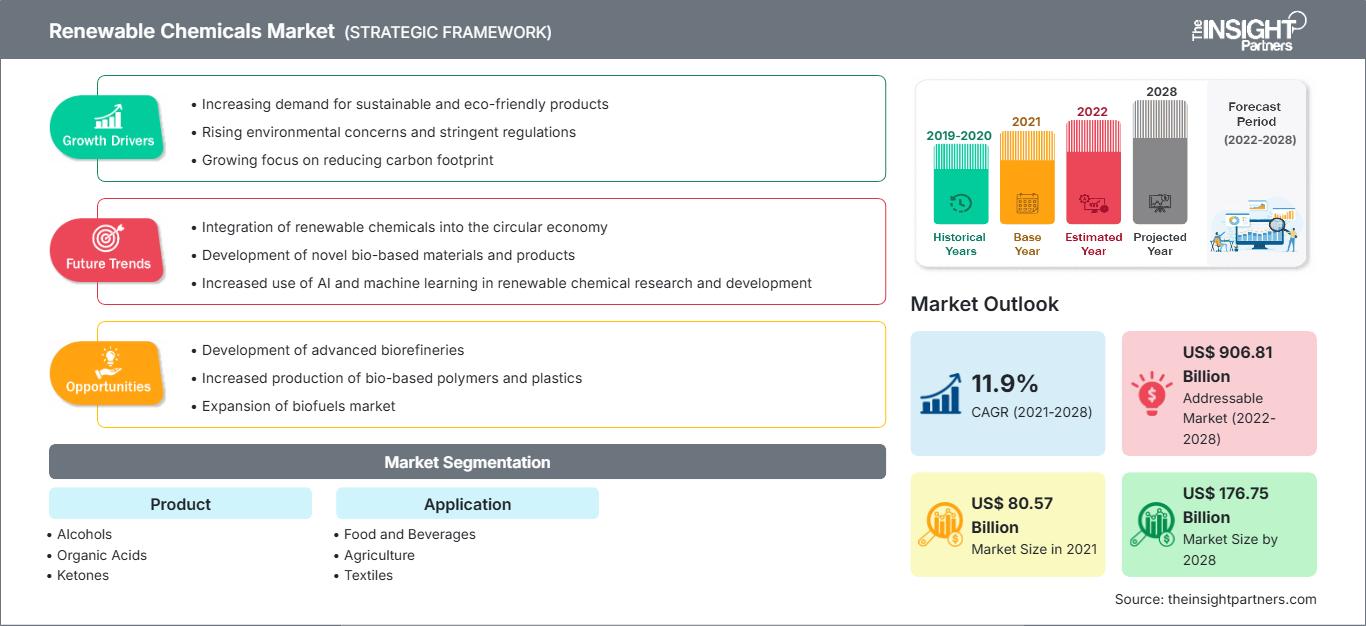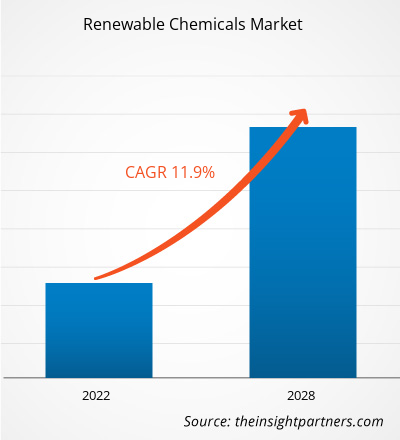2021 年可再生化学品市场价值为 805.663 亿美元,预计 2021 年至 2028 年的复合年增长率为 11.9%。
可再生化学品或生物基化学品是指由可再生资源(例如农业原料、农业废弃物、有机废弃物、生物质和微生物)合成的化学品类别。可再生化学品被归类为可持续且环境友好的化学品,与传统的石油基化学品相比,其碳足迹更少。一些最广泛使用的可再生化学品包括木质素、碳水化合物、油、植物提取物、半纤维素、纤维素、淀粉、蛋白质等。此类化学品广泛应用于食品饮料、农业、纺织、汽车、包装等多个领域。
2021 年,北美在全球可再生化学品市场中占有最大份额。该地区可再生化学品市场占据主导地位,主要得益于其强大的工业基础和知名制造业,这些因素对市场增长做出了巨大贡献。食品饮料、农业、纺织、运输、包装等行业对可再生化学品的需求旺盛,加之终端工业基地的显著增长,刺激了该地区市场对可再生化学品的需求。制造业投资的增长,以及对环保和可持续解决方案的日益关注,为北美可再生化学品市场的增长提供了丰厚的机遇。此外,鼓励使用生物基和可再生化学品替代传统石油基化学品的优惠政策,预计将进一步为该地区创造丰厚的增长机会。
自定义此报告以满足您的要求
您将免费获得任何报告的定制,包括本报告的部分内容,或国家级分析、Excel 数据包,以及为初创企业和大学提供超值优惠和折扣
可再生化学品市场: 战略洞察

-
获取本报告的主要市场趋势。这个免费样本将包括数据分析,从市场趋势到估计和预测。
新冠疫情对可再生化学品市场的影响
持续的疫情彻底改变了工业部门的状况,并对可再生化学品市场的增长产生了负面影响。为遏制病毒传播而采取的措施使情况更加恶化,并影响了多个工业部门的增长。由于国内和国际边界的突然关闭,食品饮料、农业、纺织、运输、包装、制药等行业受到了运营效率突然扭曲和价值链中断的影响。多个工业部门增长的大幅下滑对全球市场对可再生化学品的需求产生了负面影响。由于无限期封锁和临时隔离导致从供应商采购原材料中断以及制造基地暂时关闭,这些都影响了疫情期间的市场增长。尽管如此,随着各经济体计划恢复运营,全球对可再生化学品的需求预计将上升。尽管对即时生产(JIT)的关注是阻碍市场增长的另一个令人担忧的因素。食品饮料、农业、纺织、运输、包装、制药和其他行业对可再生化学品的需求不断增长,以及知名制造商的大量投资,预计将推动可再生化学品的增长。
市场洞察
日益增长的环境问题推动人们对可再生化学品的认识不断提高
可再生科学被认为是改善空气、水和土壤质量的有效方法之一,并通过在各种应用中商业化使用环保的生物基化学品来促进可持续发展。环保的可持续可再生化学品可以通过绿色化学合成或生物精炼厂从生物质、农业残留物或原料和微生物等可再生原料中获取。为促进高质量环境,多个经济体的政府已实施严格的碳排放和温室气体排放相关法规。例如,欧盟委员会的目标是到2050年将用于熟料生产的约8100万吨二氧化碳排放量减少80%。REACH(化学品注册、评估、授权和限制)、EPA(环境保护署)和欧盟委员会等监管机构对石化产品的生产和处置实施了严格的环境法规。此外,欧盟日益重视“绿色经济”建设,并推出“20-20-20”倡议,这正在逐步减少对石化产品的需求。石油资源的减少,加上主要产油国的政治不稳定以及石油产品价格的波动,增加了人们对可再生化学品的偏好。全球变暖和气候变化正在催生对健康、绿色和清洁产品的需求。此外,循环经济正在为环保技术(包括与可再生化学品相关的技术)的开发创造价值超过5.6万亿美元的新机遇。这些合作努力、法规和举措推动了可再生化学品市场的增长。
产品洞察
根据产品,可再生化学品市场分为醇类、有机酸类、酮类、平台化学品、生物聚合物等。预计在预测期内,生物聚合物将成为全球可再生化学品市场中增长最快的领域。绿色包装材料需求的不断增长,加上汽车行业对生物聚合物的使用日益增多,预计将推动可再生化学品市场中生物聚合物的增长。生物聚合物包括多核苷酸(DNA、RNA)、纤维素、壳聚糖、几丁质、淀粉、蛋白质、聚酯、果胶、胶原蛋白、明胶和麸质等。它们是减少温室气体和有毒物质排放以及不可再生资源使用的创新且前景广阔的替代品。人们对环保和可持续材料的日益关注预计将推动对生物聚合物的需求。
应用洞察
根据应用,可再生化学品市场可分为食品和饮料、农业、纺织、运输、化学中间体、包装、生物医药和其他领域。2021年,运输领域将主导可再生化学品市场。生物质、木屑、作物残茬等被转化为可再生运输燃料。各种生物基醇,如生物丁醇、生物乙醇和生物甲醇,被用作喷气式飞机的燃料。生物乙醇是运输领域使用最广泛的能源。预计未来几年生物乙醇的使用量将大幅增加并保持高位。这种向更多使用生物乙醇的转变将为未来提供更多机会。甲烷是另一种用作运输燃料的可再生化学品,也是压缩天然气的主要成分。它是由生物质通过一种称为厌氧消化的生化过程产生的。生物柴油是一种可再生柴油替代品,由任何天然油脂与醇(通常是甲醇)混合而成。各种植物油、动物脂肪和回收的食用油脂也可以转化为生物柴油。
可再生化学品市场的主要参与者包括巴斯夫公司 (BASF SE.)、阿米瑞斯公司 (Amyris Inc.)、帝斯曼公司 (DSM.)、阿彻丹尼尔斯米德兰公司 (ADM) 和陶氏化学公司 (The Dow Chemical Company)。这些市场参与者高度重视开发高质量和创新的产品。
可再生化学品市场
The Insight Partners 的分析师已详尽阐述了预测期内影响可再生化学品市场的区域趋势和因素。本节还讨论了北美、欧洲、亚太地区、中东和非洲以及南美和中美洲的可再生化学品市场细分和地域分布。
可再生化学品市场报告范围
| 报告属性 | 细节 |
|---|---|
| 市场规模 2021 | US$ 80.57 Billion |
| 市场规模 2028 | US$ 176.75 Billion |
| 全球复合年增长率 (2021 - 2028) | 11.9% |
| 历史数据 | 2019-2020 |
| 预测期 | 2022-2028 |
| 涵盖的领域 |
By 产品
|
| 覆盖地区和国家 |
北美
|
| 市场领导者和主要公司简介 |
|
可再生化学品市场参与者密度:了解其对商业动态的影响
可再生化学品市场正在快速增长,这得益于终端用户需求的不断增长,而这些需求的驱动因素包括消费者偏好的不断变化、技术进步以及对产品优势的认知度不断提高。随着需求的增长,企业正在扩展产品线,不断创新以满足消费者需求,并抓住新兴趋势,从而进一步推动市场增长。

- 获取 可再生化学品市场 主要参与者概述
报告重点
- 可再生化学品市场中的渐进式行业趋势,帮助参与者制定有效的长期战略
- 发达市场和发展中市场采用的业务增长战略
- 2019 年至 2028 年可再生化学品市场的定量分析
- 全球可再生化学品需求估计
- PEST 分析,以说明行业内买家和供应商的效率
- 了解竞争激烈的市场形势的最新发展
- 市场趋势和前景,以及推动和抑制可再生化学品市场增长的因素
- 通过强调支撑商业利益的市场战略来协助决策过程,从而促进市场增长
- 市场的详细概述和细分,以及可再生化学品行业动态
- 具有良好增长机会的各地区可再生化学品市场规模
可再生
- 化学品市场,按产品
- 醇
- 有机酸
- 酮
- 平台化学品
- 生物聚合物
- 其他
可再生化学品市场,按应用
- 食品和饮料
- 农业
- 纺织品
- 运输
- 化学中间体
- 包装
- 生物医疗和制药
- 其他
公司简介
- Archer-Daniels-Midland Company (ADM)
- 嘉吉公司
- 帝斯曼
- 巴斯夫SE
- Amyris Inc
- 赢创工业股份公司
- 索尔维
- 陶氏化学公司
- Genomatica, Inc
- Braskem
- 历史分析(2 年)、基准年、预测(7 年)及复合年增长率
- PEST和SWOT分析
- 市场规模、价值/数量 - 全球、区域、国家
- 行业和竞争格局
- Excel 数据集
近期报告
相关报告
客户评价
购买理由
- 明智的决策
- 了解市场动态
- 竞争分析
- 客户洞察
- 市场预测
- 风险规避
- 战略规划
- 投资论证
- 识别新兴市场
- 优化营销策略
- 提升运营效率
- 顺应监管趋势






















 获取免费样品 - 可再生化学品市场
获取免费样品 - 可再生化学品市场